Most EVs cost tens of thousands more than otherwise similar (and even otherwise identical) gas-engined vehicles. There’s much less of a price to be paid – in the literal sense – when you buy BMW’s i4 rather than a 4-Series Gran Coupe with an engine.
As well as in another sense.
You get more power for (relatively speaking) only a little more money.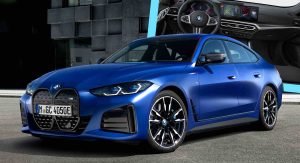
Of course, as is true across-the-board with EVs, you also pay a price in terms of how far you can go before you must stop – and how long you must wait before you can get going again.
What It Is
The i4 is a battery-powered version of BMW’s 4 Series Gran Coupe – which is actually a compact-sized fastback (and hatchback’d) sedan. It’s related to BMW’s 3 Series sedan, but the GC (and i4) are a little longer, lower and sleeker-looking. The price you pay for that is a little less head and legroom. As well as a higher price for the sleeker looking shape of the GC, which stickers for $48,300 to start vs. $44,500 for the 3 Series sedan.
But the battery powered version of the GC – the i4 – only stickers for about $4k more – $52,200 for the base eDrive35 – than the Gran Coupe, which stickers for $48,300 to start.
This is atypical for an electric vehicle. Typically, the cost of a battery powered version of the same thing with an engine is much higher than the engine-powered version.
And – in this case – it’s more than the same thing with a battery rather than an engine.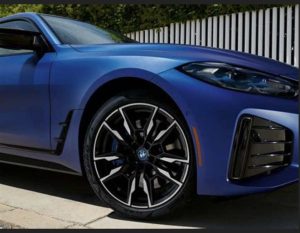
The i4 comes standard with more power than the 430i Gran Coupe, which comes standard with just 2.0 liters and 255 horses. The i4 may not have an engine – but it does have 282 horsepower.
What’s New For 2024
A dual motor (all-wheel-drive) i40 xDrive variant with 396 horsepower has been added to the lineup.
What’s Good
Only marginally more expensive than a 4 Series Gran Coupe with an engine.
More standard power than comes standard with the Gran Coupe with an engine.
Doesn’t make a visual issue of being an electric vehicle.
What’s Not So Good
As with every EV, it’s not so much the range that holds you back. It’s the time it takes to get it back.
Loses range while parked – if you don’t remember to plug it in while it’s just sitting.
Likely to depreciate faster because it’s an EV – because of the gradual/inevitable deterioration of the battery’s capacity to retain charge over time compounded by the extremely high cost of replacing any EV’s battery.
The i4 comes standard with rear-wheel-drive and a 282 horsepower, 70.2 kWh battery pack and 276 miles of fully charged range. This is a significant power upgrade over the 430i Gran Coupe’s 2.0 liter four cylinder engine that only makes 255 horsepower. But the price you pay for the additional power is less range – 276 miles overall vs. 390 miles in city driving and 530 miles on the highway for the 430i.
As well as more time.
BMW says it takes about 7 hours to recover a full charge at home via a “Level II” system that uses 240 volts; i.e., an electric stove/clothes dryer-type outlet – which you may have to have wired up by an electrician if your garage doesn’t already have a 240V outlet to plug into. And that is the fastest you can recover a full charge at home because private homes don’t generally have the power to charge an EV any faster.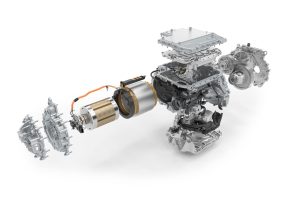
You could reduce the time you’ll have to wait by driving to a commercial “fast” charger, which is faster-charging than charging at home. But you’ll still have to wait about half an hour to get a partial (80 percent of capacity) charge. This is the case with all EVs as a precautionary measure; fully charging the battery at a “fast” charger degrades the battery’s capacity to hold a full charge and also increases the risk of a fire, due to the heat generated. That’s why “fast” charging is limited to 80 percent of capacity. Which means 20 percent less capacity – which means you’ll be back on the road with about 220 miles of range (for the eDrive35) unless you have a lot more time to wait, while the remainder is recovered slowly.
If you’d like to go a little farther in between stops – and so have to stop less often – and have more power to go along with the ride – you can upgrade to the eDrive40 version of the i4. It comes standard with 335 horsepower and 301 miles of range.
This version of the i4 is also rear wheel drive.
New for this model year is the xDrive40, which has dual motors and so all-wheel-drive. It also has 369 horsepower and about the same driving range (307 miles).
BMW also offers a high-performance “M” version of the i4 – the M50 – which also has the dual motor setup but offers a maximum of 536 horsepower using the “boost” button. This version of the i4 touts the least range (269 miles) as you’d expect given its focus on power/performance.
On The Road
The i4 accelerates immediately, powerfully – and silently. These being the main draws of battery-powered vehicles. The problem, of course, is that accelerating powerfully costs energy. This is no different when you accelerate a gas-engined vehicle forcefully. But the difference is that it only takes a few minutes to completely refill a gas-engined vehicle’s tank – as opposed to waiting 30 minutes for 80 percent of fully charged.
There’s another difference, too.
Your range – with an EV – will often vary. Often considerably. And even when you haven’t been driving it.
When they dropped off the i4 for me to test drive, the dashboard display said there were 269 miles of driving range available. After my first drive of about 30 miles, the indicator said I had about 241 miles of range remaining. In other words, according to the i4, I had only used up 28 miles of indicated range to travel 30 miles. I was impressed by this because it is typically the case that the range-you-can-drive estimate is off by about 20 percent – and not in your favor.
But when I went to drive the car again after leaving it parked for a day, the range remaining indicator had gone down to 196 miles – even though I hadn’t driven the i4 at all.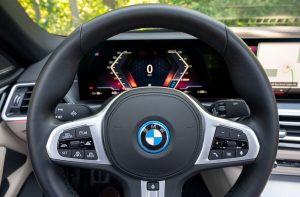
But I did leave it parked – and unplugged. The loss of charge (and so, range) probably being a consequence of the car using up charge to keep its battery from getting too cold or too hot, either of which can damage the battery or make it hard to charge the battery.
All EVs have thermal management systems to maintain the battery within its optimal temperature range – and so EVs are always using power, even when they are parked. Thus, if you don’t plug the EV in when you park it – to keep the battery topped off – when you need to drive it again, you will discover you won’t be able to drive it as far as you expected to be able to drive it.
Also, the range remaining indicators EVs have are not like the fuel remaining indicators gas-engined vehicles have, which measure the volume of fuel you have remaining in the tank. The range-remaining indicators estimate the range you have left by calculating various variables, such as the outside temperature and also how you drove the vehicle last time you drove it. These are all variables – and so the actual range you have varies along with it.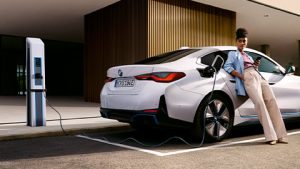
You have to learn the car as it learns you. And – of course – you have to be more aware of how far you can realistically go, because of the time it takes to get going again.
Other than that, the i4 drives – and handles – very much like 4 Series Gran Coupe it is, sans the engine. The chief differences being that it accelerates more forcefully at first – because of the greater power (and instant torque delivery) of the electric motor(s). But its force wanes as speed build because of the weight that those motors have to push. The rear-drive i4 eDrive35’s curb weight (4,553 lbs.) is 761 lbs. greater than that of the 430i (3,792 lbs.) and that slows the i4 down as it tries to go faster.
If you have a look at EV top speed numbers, you’ll discover that while most of them are very quick (0-60) they aren’t very fast, with top speeds for most in the 130 MPH range or less.
On the upside, the i4 feels more substantial than the compact-sized car it is. Because it is more substantial. Literally. The i4 weighs more than most full-size sedans that aren’t battery powered and that lends it a gravitas non-electric compact-sized cars lack.
At The Curb
The original Prius hybrid was polarizing because it made a point of looking like a hybrid – which was fine if you wanted to make a point about driving one. Many people just wanted to drive high-mileage car. The i4 is styled for the person who just wants to drive an electric car.
It does not look like one. More finely, it does not look like a Tesla 3, which makes this BMW the EV for the person who prefers to just drive one and not make a big deal about it.
One of the handy things about it is the hatchback layout, which opens up the available space for whatever you need to carry considerably by opening up the entire interior of the car and by the much larger opening of the hatchback itself. The total cargo space claimed is 16.6 cubic feet but it’s functionally more than that because of the fact that more will fit in a pinch if you leave the rear liftgate open and fold forward the back seats. The interesting thing here is the i4 (and the 4 Series GC it’s based on) is both more practical and more stylish than the 3 Series sedan they’re based on.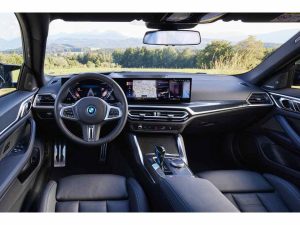
You don’t even lose much in the way of head and legroom vs. the 3 sedan, which has 42 inches of legroom up front and 35.2 in the back vs. 41.5 in the i4 up front and 34.9 in the rear. Headroom in the i4 (and 4 Series GC) is also just a little bit less: 38.6 inches up front and 36.6 inches in the rear vs. 38.7 up front in the 3 Sedan and 37.6 in back. You wouldn’t think it to look at it.
Or – rather – them.
The 3 Sedan is an attractive sedan but the i4/GC are more so. The latter look lower and racier. The latter for real, the former just a visual effect of the sharper rake of the glass and the slinkier-looking fastback rear styling. In fact, all three – the 3 Sedan and the i4/GC – stand about the same 56.8 inches off the ground.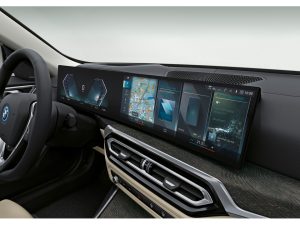
There are some differences inside.
The i4 has a single rectangular sheet LCD driver information cluster and – naturally – different information, such as a power/charge display in place of a tachometer. There’s also a range-remaining display that recalculates range remaining as you drive (and while the i4 is parked). You may find you have more indicated range remaining – or less than you thought you had – depending on the computer’s estimates.
BMW equips all i4 trims with most of the same standard features. The main differences between trims being the output of the electric drivetrains, the driving range and the availability (or not) of some performance-enhancing equipment such as the M Sport package that includes an adaptive suspension system; the M Sport package is not available with the eDrive35 but is optional with the eDrive40 and sDrive40. The M50 comes standard with the M Sport stuff and can be ordered with larger 20 inch wheels and a Carbon trim package.
Be aware that choosing the taller tires (and heavier wheels) will reduce the vehicle’s driving range a little.
The Bottom Line
Here’s an EV that doesn’t look like one – or cost much more than one. At least in terms of what you pay for it vs. the car that looks just like it but isn’t one.
. . .
If you like what you’ve found here please consider supporting EPautos.
We depend on you to keep the wheels turning!
Our donate button is here.
If you prefer not to use PayPal, our mailing address is:
EPautos
721 Hummingbird Lane SE
Copper Hill, VA 24079
PS: Get an EPautos magnet or sticker or coaster in return for a $20 or more one-time donation or a $10 or more monthly recurring donation. (Please be sure to tell us you want a magnet or sticker or coaster – and also, provide an address, so we know where to mail the thing!)
If you like items like the Baaaaaa! baseball cap pictured below, you can find that and more at the EPautos store!



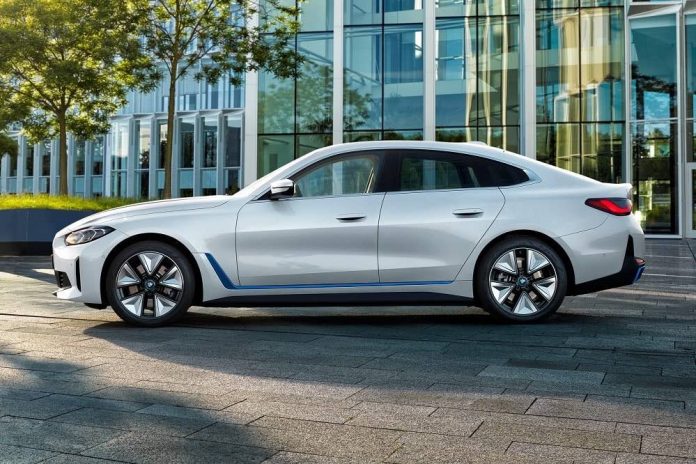




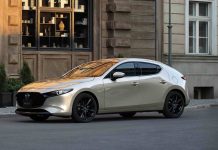





Volvo has doubled-down on going 100% EV, and will soon join Saab in oblivion. MB & VW are now dropping multiple EV platforms to prevent doing the same:
https://www.youtube.com/watch?v=vjiBzn9o54c
Slaves don’t want…and can’t afford $50,000 EV’s
Unsold Teslas Pile-Up In Mall Parking-Lots, Big Discounts Likely
People don’t want to burn to death, in an over weight, over priced golf cart?
According to its own figures, the electric automaker produced 46,561 more vehicles than it delivered to customers during the first quarter of 2024
Another Round of Mass Firings at Tesla, Sales Must Be Imploding
Full Self Driving (FSD) is nonexistent, but promised “next year”, every year since 2016.
For four years running, Musk promised to make 50,000 electric semis. Tesla delivered a grand total of 100.
https://www.zerohedge.com/markets/unsold-teslas-pile-mall-parking-lots-big-discounts-likely
Microwave your lunch in your EV when it is charging?….lol
Sit in your EV when charging and get microwaved and if you are unlucky the lithium fire bomb battery will catch fire and incinerate you….
Health damage from EMF radiation from EV’s
Since Tesla is an electric car with a large battery and an electric motor, it emits high amounts of EMF radiation. The latest models emit high levels of electromagnetic radiation.
Dangers of EMF Radiation from Tesla Cars and Other Electric Cars
According to a study by Scripps Clinic Research Foundation, high levels of EMF from EVs make the drivers drowsy and sleepy while driving. Based on the study, drivers who are exposed to high levels of EMF while driving are likely to sleep 52 minutes faster than those exposed to low levels of EMF. Is this why there are so many tesla, EV, crashes?
In addition, exposure to radiation while driving can result in headaches, neck stiffness, and dry eyes or blurred vision. Long-term exposure to these sources of EMF radiation may have long-term health complications.EMF Radiation from Electric Cars
blurred vision…..is this causing crashes?
According to Dr. Joel Moskowitz at the University of California Berkeley, hybrid cars and other electric cars have increased levels of ELF that cause cancer, increase the level of oxidative stress that leads to DNA fragmentation, cause cell damage, fertility issues, drowsiness, etc.
So drive an EV and get…..damaged DNA , cell damage, get sterilized, get drowsiness and crash….lol
Electric cars, including the Tesla EV do emit a dangerous amount of EMF ……….Electric cars do emit more radiation compared to standard fossil fuel vehicles.
If you sit in your EV when connected to the super charger/ high speed charger you get microwaved, stay away from the car when it is charging.
Stay out of the car….lol……….this will be interesting in the middle of the night, in a dark parking lot, when it is snowing and freezing out….lol….these Ev`s are a safety hazard in many ways…
Avoid Sitting in the Car While Charging the Battery
When supercharging the battery, a high amount of EMF is emitted, therefore, do not stay inside the car.
Charging the car creates substantial amounts of dirty electricity (DE). When you charge your car in the garage, you are putting extremely high levels of DE onto the wires of your entire home. turn your house into a microwave oven….lol
To supply electricity for EV`s the electrical grid has to be expanded by 500%, so the EMF radiation from the transmission, distribution lines will increase 500%, destroying people`s health.
This is especially problematic as most people charge the car overnight when the occupants are sleeping – the time of day when we want our EMF exposure to be as low as possible.
they went on and on for 2 1/2 years about a mild flu, relabeled as a dangerous bat germ, but haven’t said a word about this health issue, that is actually real and 100 x worse then a mild flu.
https://emfguardtips.com/do-electric-cars-emit-emf/
I can run my laptop for six hours before the battery will need to be re-charged. There will be a warning, the battery has spent the juice, prug it in, goes to 100 percent in about 1.5 hours.
Don’t have to monitor the charge until the computer says the battery needs charging.
The machine will shut down in three minutes, something like that when the battery simply stops and you need to find the block with the USB-C cord, voila, back to 100 percent. You then unprug the laptop, it can be used for another six hours. The laptop battery uses 99 percent of the charge, the Energizer bunny can’t do it like that.
Piece of cake, use laptop Lithium batteries, those seem to work okay. A thousand of them in an electric vehicle should yield 6000 hours of driving time before the batteries have to be charged. Absurd, I know, but the picture in the real world is just as absurd.
The biggest issue is battery life, next is distance traveled for the charge, then you are shackled to 60 percent of battery capacity, back to the charging station to do it all over again. A waste of 40 percent of the electricity, won’t be used, can’t be used. You are going to pay for it no matter how. 300 mile range, you drive 180 miles or less, time to recharge the battery.
This thing eats electricity forever and a day.
Not again, Jesus, I want my life back.
It will be a bummer and will get really old.
One Tesla owner strapped some explosives to the exterior body panels and detonated the thing.
You gotta do whatcha gotta do.
You know they are going to burn out after 100,000 miles or so, might burn up before then.
Fill deep dug pits with dead EVs and flood the pit with water so they all burn by auto-immolation.
The savings on explosives will pay for more deep dug pits to be used for EV extermination.
Kill them all! The Final Solution!
Electric Vehicle Holocaust to the rescue!
All done by writing it all down from the laptop with a lithium-ion battery.
Water happens to be Kryptonite for lithium-ion batteries.
You’re a hero for reviewing cars almost no one wants!
How about some comic relief?
https://electrek.co/2024/05/12/tariffs-on-china-arent-the-way-to-win-the-ev-arms-race-taking-evs-seriously-is/
“Cars are changing quickly, as is car manufacturing. The leaders of today, and of the last half-century, are not guaranteed to remain the leaders in the face of new entrants and new technology. And most of all, a new powertrain – electric – that will account for roughly 100% of cars on the road within a couple decades, which no serious person disputes.
Further, as one of the most polluting sectors globally and the most polluting in rich countries, it is necessary that transportation clean up its act, and fast, in order to avoid the worst effects of climate change. The sooner this happens, the easier it will be for all of us.
The new entrants to car manufacturing aren’t just in the form of startups like Tesla or Rivian, but in the form of nations which previously did not have a large presence in international auto manufacturing, but will take advantage of this flux to become more competitive in a changing global market.”
*reaches for bourbon bottle*
Since I’ve built some battery chargers for lithium batteries, I’d like to add a little bit of context as to why battery charging slows down at around 80%. It’s not out of an abundance of caution, it’s physics.
When you charge a battery, what happens is that you create a voltage that’s higher than the battery’s, which causes current to flow into the battery. The charger has to precisely control the voltage to be a little bit ahead of the battery’s voltage as it charges, so that the current stays within specifications. What this means is that the charger’s voltage slowly rises along with the battery’s voltage, feeding in roughly constant current (amps). Battery cells have a maximum allowable voltage, so once the charger reaches that voltage, it can’t raise it anymore, and simply stays at that voltage, but the battery voltage is still rising slowly. The amount of current flowing into the battery depends on the voltage difference between battery and charger, so once you reach the max voltage, the closer the battery gets to it, the slower it charges. Charging past roughly 80% is useless on a fast charger because it turns into a slow charger, and there’s no thing you can do about it, even if you want to ignore safety. Exceeding the max voltage will damage the cell.
Batteries are unfit for purpose as energy storage devices in EVs. That’s a logical consequence of what you’ve written here.
I’d not go that far. EV’s aren’t for me, but I can see why others like them. It’s too bad they’re being shoved down our throats, and that ICE cars are more expensive due to paying for EV credits. Quit mandating, quit subsidizing, and let Mr. Market decide.
When the technology has such lousy performance that it cannot even meet embarrassingly modest expectations of a 0 – 100 % charging time of five minutes at the most, and provide at least 300 miles of realistic range in an EV, then that technology is unfit for purpose, especially if the laws of physics make it impossible to fix the underlying problem that causes the lousy performance in the first place.
Another eeeeeveeee.
have you measured electromagnetic frequencies and the effects from riding on a giant batter?
Hi Buick,
No – but I am glad you brought this up. I plan to buy a good EMF meter to find out just how much is being “emitted” by these EVs. I’ll do it as soon as funds permit and add this info to every review of an EV I do.
https://www.homedepot.com/p/LATNEX-All-in-One-EMF-Meter-AF-3500-AF-3500/318875722?source=shoppingads&locale=en-US&pla&mtc=SHOPPING-CM-CML-GGL-D27E-027_011_TOOLS_ACC-NA-NA-NA-PMAX-NA-NA-NA-NA-NBR-NA-NA-NEW-NA_2024__WHU24&cm_mmc=SHOPPING-CM-CML-GGL-D27E-027_011_TOOLS_ACC-NA-NA-NA-PMAX-NA-NA-NA-NA-NBR-NA-NA-NEW-NA_2024__WHU24-71700000118279182–&gad_source=1&gclid=CjwKCAjw9IayBhBJEiwAVuc3fuH2z3IAcFBp_nRLNn1dz4f2mdz_6MfSiK_YKg0ePxWDwcFiiZC6jBoCuyAQAvD_BwE&gclsrc=aw.ds
Here is one.
Huh, that side shot picture looks like a near twin to my daughter’s 2015 Mazda 6, same pearl white paint to boot! She snagged it in 2019 for $17500 with 42k on the clock.
I’ll take the Mazda over the Breaks Many Ways thank you very much.
(One battery $140 and oil changes that’s it!)
What’s the BMW dealership gonna do to replace their exorbitant service / maintenance fees?
Electric Vaccines look like they can cure the ICE disease, but electric vaccines don’t work any better than the current vaccines that don’t work, cure nothing, and people do die suddenly.
Some EV drivers die suddenly while driving, hard to cure that disease, auto-immolation just happens all of a sudden. Israel is kind of auto-immolating and could die suddenly. Your EV could die suddenly and then you’re stranded.
If you don’t own one, not to worry, not your problem. If you didn’t get vaccinated, you are among the very lucky indeed. No fear of dying suddenly, you’re clear.
Ford could die suddenly, GM could die suddenly.
You want to vaccinate your ICE engine to keep it alive, so go to the gas station and fill up your tank.
Good old Oklahoma crude is the best vaccine ever. Farmers go for hydrocarbons, which cure many problems and diseases.
Visit your farmacy.
‘The rear-drive i4 eDrive35’s curb weight (4,553 lbs.) is 761 lbs. greater than that of the 430i (3,792 lbs.)’ — eric
What a bloated barge … for a vehicle with a 112-inch wheelbase.
One might think that advances in materials would have resulted in cars getting lighter compared to half a century ago. But one would be wrong — like the American population, cars are porking out like never before. And EeeVees are the worst-of-class offenders.
Talk about incoherent aesthetics: Eric’s photo shows BMW’s stupid lozenge-shaped gauges that I despise, in front of a Clownwheel festooned with sixteen (16) buttons. The lozenge-shaped theme extends to the air vents over the center console. But the multiple, clunky rectangular display panels in the penultimate photo, with their hard square edges, look like they’ve been velcro’d to the dash by a teenaged kid at Ace Hardware. Apple would never design uncouth crap like this for its wheel-less cell phones.
What a designer’s dog’s breakfast. Any cachet that BMW may have had decades ago — as an object of desire for yuppies in the Reagan administration — is so last-century. I doubt I’d even waste a match — or a bullet — to set this flaming turd alight. God willing, de-industrializing Germany won’t even have an auto industry by 2035. Just stop now.
My sister got lucky, married a yuppie
Took him for all he was worth
Now she’s a swinger dating a singer
I can’t decide which is worse
— Tom Petty, Yer So Bad
At least it has buttons! Better than touchscreens for sure.